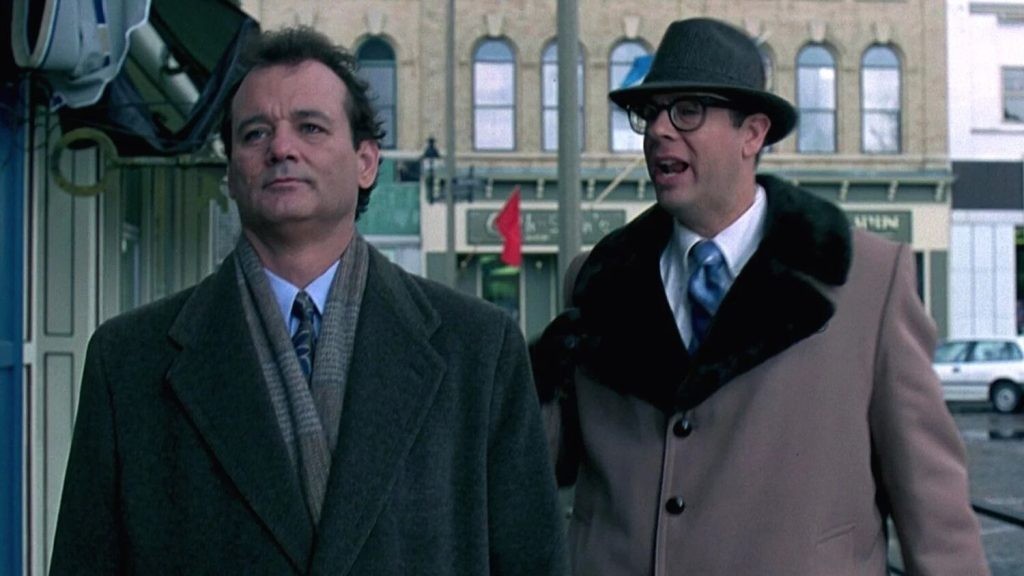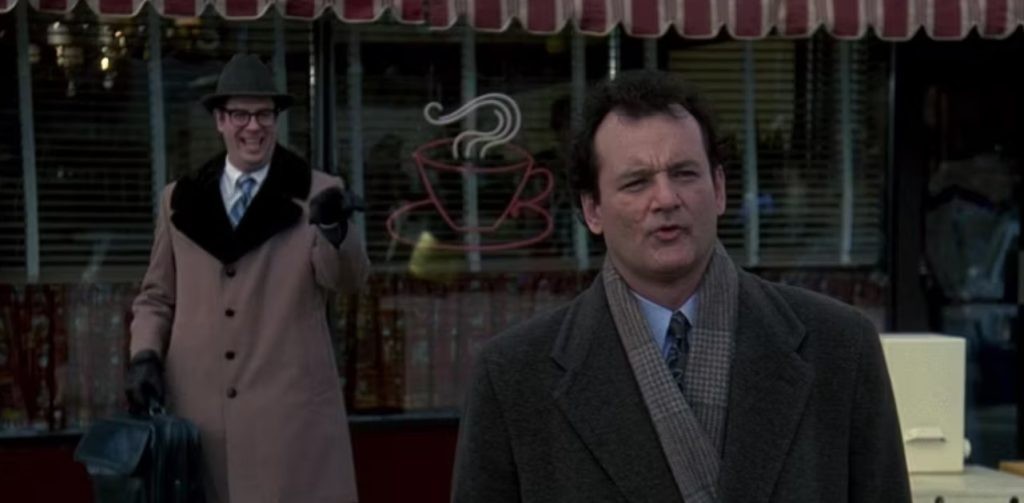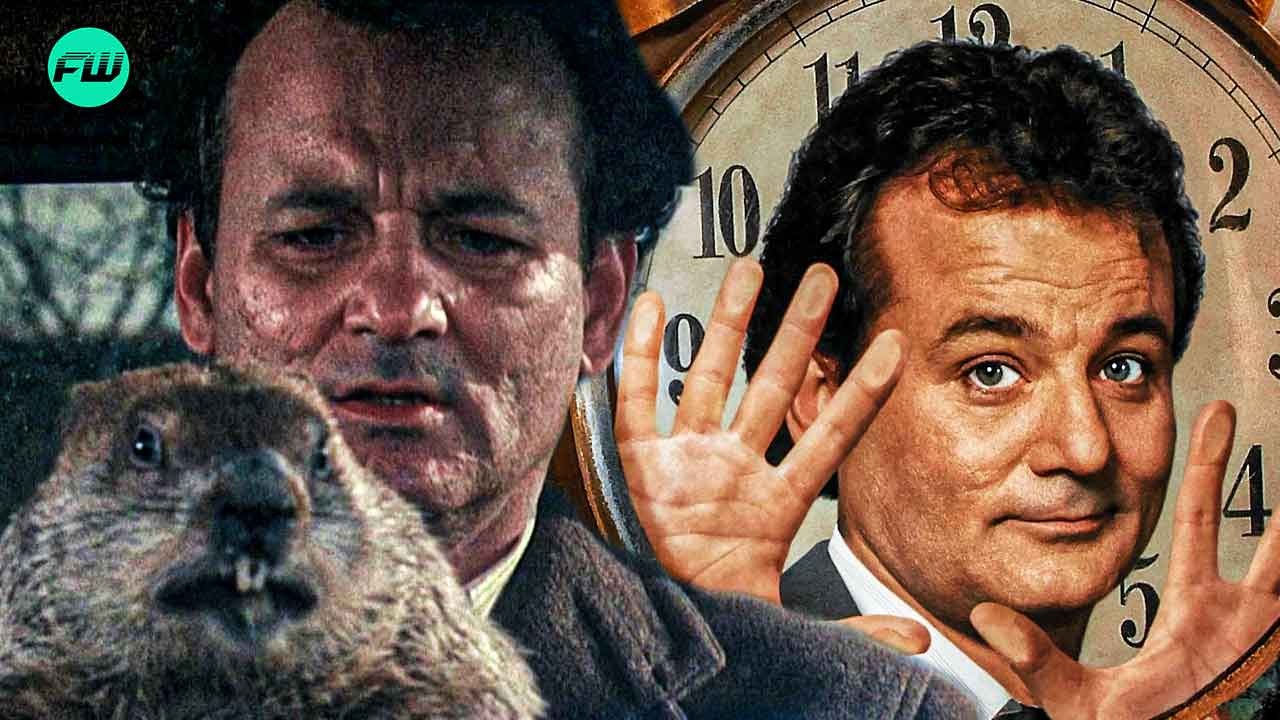According to this mind-blowing Groundhog Day (1993) theory, the Devil doesn’t always wear horns—sometimes, he appears clad in a winter coat and a hat, carrying a briefcase, on his way to coax someone into buying life insurance.
Similarly, purgatory in the Bill Murray classic is being stuck in Punxsutawney in a seemingly eternal time loop of which others are unaware. As our main character, a cynical, self-involved weatherman, moves through the intermediate stage, we eventually see his transformation, a redemption into using his potential for good.

And the cycle does break. But there may be graver subtext to what it may mean for the journey Phil Connors underwent. While the act of self-actualization and betterment may have been the cornerstone for the protagonist’s liberation from—whatever you call it—purgatory or hell, his deal with the Devil may turn the previously established themes of the film on its head.
In this theory, the Devil in disguise is Ned Ryerson, an insistent insurance salesman whose treatment in the film is reduced to gags. However, this attribution provides a darker twist to the overarching narrative, with two possible resolutions. Of which, one is particularly sinister.
Theory: Ned Ryerson Is The Devil And The Secret Villain Of Groundhog Day

The Groundhog Day theory, suggested by Redditor SuperConductiveRabbi, frames Ned Ryerson as the Devil in the comedy helmed by Harold Ramis.
As per the user, the tormenting time-loop Bill Murray‘s Phil finds himself in, which never gets a concrete explanation, may be a by-product of the first time he encounters Ned. The latter runs up to the self-centered weatherman, introducing himself as a friend from high school. Based on his demeanor, Phil has little to no clue who he is.
We then get a rather suspicious response from Ned after he observes the protagonist’s nonchalance. “Don’t you tell me you don’t remember me because I sure as heck fire remember you,” he says. The viewers soon see the Stephen Tobolowsky-portrayed character coax Phil into buying life insurance. The scene culminates in the latter’s refusal.
In dismissing Ned, Phil steps right into a puddle. This amuses the former, who says, “Watch out for that first step; it’s a doozy!” And this first step is not signifying the literal implications of the scene. It is, instead, Phil’s ‘first step’ into a cycle of torment, of a seemingly never-ending loop.
One element validating this is the shot’s framing, where Phil steps into the puddle. It shows behind him a shop with a red coffee cup symbol and steam coming off it (an allusion to Hell?). Ned laughs in the background almost devilishly.
Therefore, the theory implies that Phil only gets trapped in the loop after he refuses the Devil’s offer.
This is where the theory could diverge into two interpretations: Ned is pursuing Phil’s soul, and purchasing the insurance would metaphorically seal the deal. Or, it could also be the ‘Devil’ teaching the self-absorbed, arrogant weatherman a lesson by punishing him for his selfish deeds. It is Phil’s refusal, in this case, an act that solidifies his inconsideration and grants him the punishment.
Ned Being The Devil Has Deeper Implications For Groundhog Day

The theory points out that it’s not Rita or even Phil’s redemption arc that liberates him from the hellish torment. The latter, nevertheless, helps leading up to the moment that eventually shatters the cycle. The last day of the loop is when Phil finally buys several insurance policies from Ned and treats him respectfully instead of dismissing him entirely. Soon after, time returned to normal, and Phil moved on to February 3rd. Hooray! Right?
Well, it depends. There could be two ways the ‘Devil’ theory impacts the overarching narrative of Groundhog Day and especially the conclusion. One interpretation is that signing on the insurance, accompanied by other selfless actions leading up to the point, proves to be the final act that absolves Phil’s sins.
Ned, as the Devil, takes this as a confirmation of the protagonist’s development and deems it the right moment to free Phil from the time loop. Teaching him a lesson could’ve been the Devil’s goal, and now that the lesson was learned, what use would it have to keep Phil entrapped?

This interpretation would adhere to the overarching themes of Groundhog Day—redemption and penance. Phil only learns the virtues of acceptance and making the most of his day after going through a purgatorial circle. He lets go of his arrogance and egocentrism and stops taking hedonistic advantages out of the scenario.
And this take on the theory does retain the ‘happy ending’ element of the premise.
The alternative explanation, though, is less pleasant and can imply that Phil will never escape the Devil.
Phil Sells His Soul To The ‘Devil’
The more melancholy interpretation renders Phil’s deeds of compassion irrelevant to the story of Groundhog Day. Some believe that under the ‘Devil’ theory, putting the protagonist through the harrowing loop was Ned’s way of getting a hold of his soul. Holding him in the cycle and building up to the point where Phil’s redemption would seem like his saving grace ultimately leads him to buy the insurance policies. This final act seals our main character’s fate.
Phil literally makes a deal with the Devil. And in exchange for his soul, the Devil, as Ned, grants him his desire. An escape from the cycle. A ‘too-good-to-be-true’ ending. It is almost as though Phil succumbs to the Devil’s temptation. And who knows? Perhaps this isn’t his salvation, after all. Maybe it’s a promise of a temporary ‘escape.’
With his soul in the hand of the Devil, this interpretation makes Groundhog Day far scarier.

This take on the theory also cements the spiritual symbolism. Ned getting Phil to sign the deal was him swaying Phil into eternal damnation, disguised as sweet heaven. Anybody else getting vibes similar to The Good Place?
Then again, this interpretation deviates from the purgatory-esque representation. If the previous one is to be believed, Phil goes through purification, is absolved of his sins, and ends up, in fact, in what one can deem ‘heaven.’
Nonetheless, this is just a theory, a film theory! And even if these interpretations conflict with the actual story envisioned by the creatives, it shows how subjective art can be. And besides, Ned being the ‘Devil’ gives a backdrop to the mystery behind what gets Phil stuck in the time loop in the first place. Much to think about, really.




